The VMI Fine Art Collection
Virginia Military Institute maintains a large collection of fine art and artifacts. Some of the most notable examples from VMI's art collection, including works by 19th century artist William D. Washington, are displayed in Preston Library.
The VMI Museum is the office of record for the fine art collection, and inquiries may be directed to the registrar of the museum.
This page lists only those works exhibited in Preston Library. Thumbnails of the portraits and other paintings shown below are from photographs of the original artworks and part of the VMI Archives collection.
Preston Library 4th Floor
Gallery
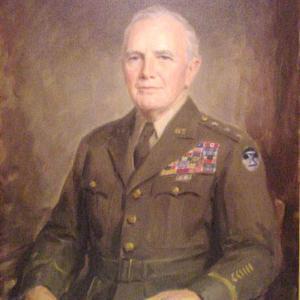
Lt. Gen. Edward M. Almond, VMI Class of 1915, by David Silvette (1909-1992), Oil on Canvas
Edward M. Almond was born in Luray, VA in 1892. He attended Virginia Military and commissioned into the U.S. Army as an infantry officer. He was promoted to Captain in 1917 when the United States entered World War II. In 1918, Almond fought in the Argonne Defensive and was awarded the silver star. Almond attended the Army War College in 1934. He was Commanding General of Task Force 92 1942. General George C. Marshall promoted him to Major General, and then Almond became Chief of Staff of the VI Corps. Almond also fought in the Korean War and remained in command of the X Corps until 1951. He was given command of the Army War College from 1951 to 1953, where he retired from the military and became a member of the supervisory at VMI.
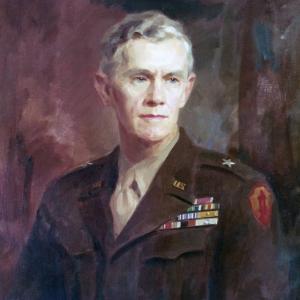
General Oliver Bucher, VMI Class of 1917, by David Silvette (1909-1992), Oil on Canvas
Oliver B. Bucher was born in Bridgewater, VA in 1890. He was the commanding general of the Trinidad Base Command U.S. Army from 1944-46. Bucher was the Commandant of VMI from 1946-51.
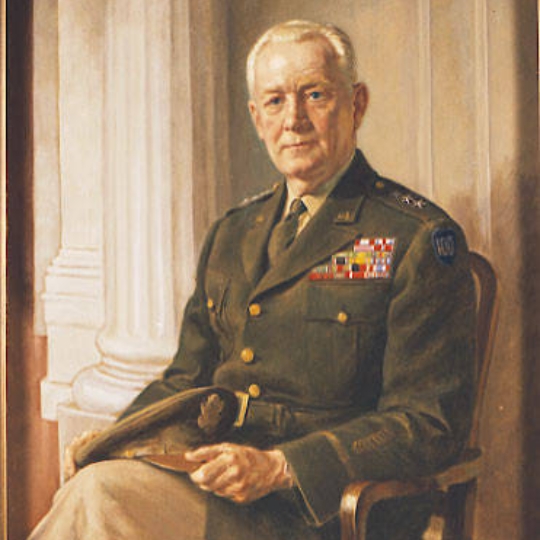
Maj. Gen. Withers Burress, VMI Class of 1914, Henry A. Nordhausen, (1901-1993), Oil on Canvas
Withers A. Burress was born in Richmond VA in 1894 and attended the Virginia Military Institute. He commissioned into the U.S. Army as a second lieutenant in the infantry. Burress served in World War I with the 23rd Infantry Regiment. He served as VMI Commandant from 1935-1940. During World War II Burress was the mobilizing commander of the new 100th Infantry Division—he would be their commanding general until the 100th was demobilized at the end of the war. He was then promoted to command the VI Corps in 1945, and Inspector General for the European Command in the immediate post-war era.
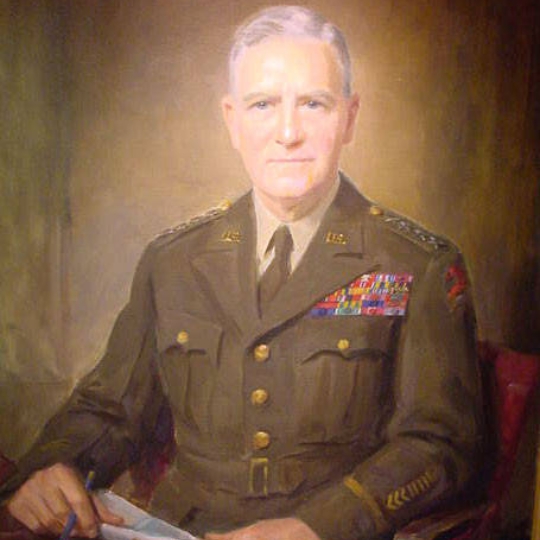
Gen. Leonard T. Gerow, VMI Class of 1911, by David Silvette (1909-1992), Oil on Canvas
Leonard T. Gerow was born in Petersburg VA in 1888. He attended Virginia Military Institute where he graduated with a Bachelor of Science in 1911. When World War II started, he was chief of the War Plans Division of the General Staff of the U.S. Army under General Marshall. Gerow helped plan Operation Overlord. He was assigned to command the 29th Division at Fort Meade in February of 1942, then in October of the same year he went with the division to England. Gerow was assigned to command the V Corps in 1943 and commanded them all the way through their landing on Omaha Beach where he was the first corps commander ashore. Gerow was a 2-star general at the Battle of the Bulge, and was then promoted to a 3 star on January 1st, 1945. He assumed command of the 15th U.S. Army on January 15, 1945. Gerow was also the first American general officer to enter Paris following its liberation.

Gen. Thomas T. Handy, VMI Class of 1914, by David Silvette (1909-1992), Oil on Canvas
Oil portrait of U. S. Army Gen. Thomas T. Handy. Thomas T. Handy was born in Spring City, TN in1892. He graduated from Virginia Military Institute in 1914 but did not commission into the U.S. Army until 1916. Handy served in World War I on the German front and then returned to VMI as a professor from 1921 to 1925. He graduated from the Army War College in 1935 and then attended the Naval War College. During World War II he served as the Deputy Chief of Staff from 1944 to 1947. He was the commanding general of the 4th U.S. army from 1947 to 1949, then Commander in Chief of the U.S. European Command from 1949 to 1954, and then the Commander in Chief of the U.S. European Command.
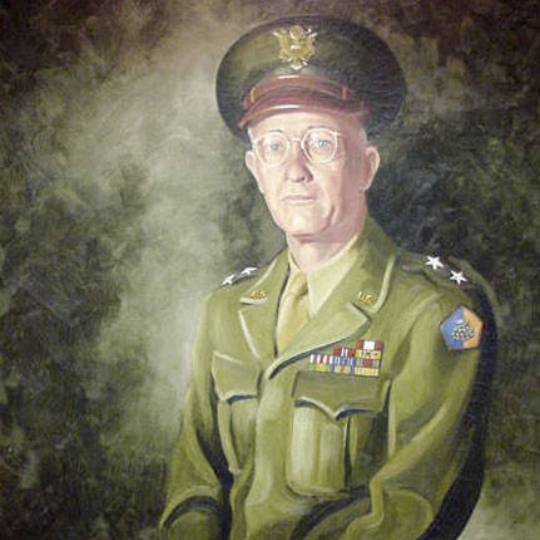
Lt. Gen. Sumter Lowry, VMI Class of 1914, artist TBD, Oil on Canvas
Sumter D. Lowry was born in St. Augustine FL in 1893. He attended the Virginia Military Institute and graduated in 1914. Lowry joined the Army as a Captain and served in the Florida National Guard. He served in the Pancho Villa Expedition at the Texas-Mexico from 1916 to 1917. Lowry was sent to serve in World War I in France, but the armistice was signed before his company saw any action. During World War II, Lowry participated in the Dutch East Indies and New Guinea campaigns where he received a Bronze Star Medal. He helped the Florida National Guard reorganize after WWII and was promoted to major general. Lowry retired from the Florida National Guard in 1952 and was promoted to lieutenant general and was awarded the Army Distinguished Service Medal.
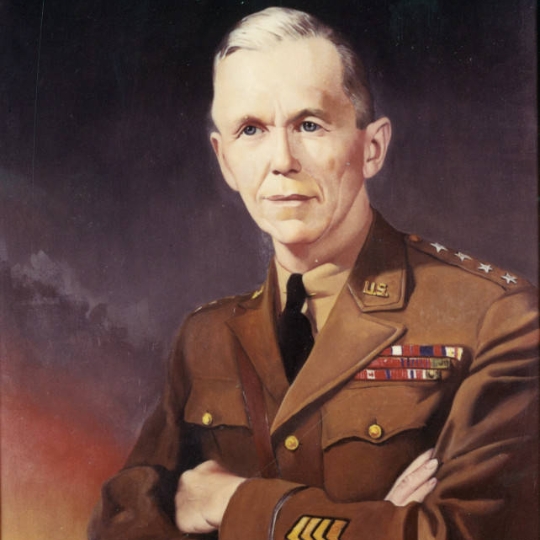
Gen. George C. Marshall, VMI Class of 1901, Leslie Emery (1912-1988), Oil on Canvas
George C. Marshall was born in Uniontown, PA in 1880. He commissioned into the U.S. Army as an Infantry officer in 1902. Marshall served in the Philippine-American War and then graduated the Army Staff College in 1908. Marshall served in World War I in the staff of the 1st division where he assisted in planning the Meuse-Argonne Expedition. He became the Army's Deputy Chief of Staff in 1938 and then became the Chief of Staff from 1939 to 1945 during World War II. Marshall was the General of the Army and planned Operation Overlord and coordinated Allies operations in Europe and the Pacific until the war ended. Marshall retired in 1945 but remained on active duty because of his five-star rank, one of only five U.S. Army officers to hold that rank.
He served as envoy to China from 1945 to 1947 to help negotiate between the Nationalists of Chiang Kai-shek and the Communists of Mao Zedong. Marshall was Secretary of State from 1947 to 1949 during which time he implemented the European Recovery Plan, better known as the Marshall Plan. Marshall served as Secretary of Defense during the Korean War and Cold War. Marshall was awarded the Nobel Prize for Peace in 1953.Marshall served as U.S. Army chief of staff (1939-45), U.S. Secretary of State (1957-49), and Secretary of Defense (1950-51). He received the Nobel Prize for Peace in 1953.

Gen. Randolph Mc. Pate, VMI Class of 1921, by Benton H. Elliott (1918-2008), Oil on Canvas
Oil portrait of USMC Gen. Randolph McCall Pate, Commandant, U.S. Marine Corps. Randolph McCall Pate was born in Port Royal, SC in 1898. He was prior enlisted in the U.S. Army until 1918, at which time he entered VMI. Pate commissioned into the Marine Corps, eventually serving as 21st Commandant of the Marine Corps from 1956 to 1959, succeeding General Lemuel Shepard, VMI 1917. Pate was awarded the Army Distinguished Service Medal, the Navy Distinguished Service Medal, the Legion of Merit and the Purple Heart.

Bust of Philip B. Peyton, VMI Class of 1901 by Cathe Wallendahl (1897-1977), Bronze.
Major General Philip B. Peyton, VMI Class of 1901.
Archives Reading Room

Citation from Chiang Kai-shek, by unknown artist, Rice Paper
This is made of rice paper with black ink. The transcription is as follows: Citation from Chiang Kai-shek, President / Republic of China / TO THE LEDERLE LABORATORIES OF THE UNITED STATES, WHOSE GENEROUS / CONTRIBUTION OF MEDICINAL SUPPLIES IS DEEPLY APPRECIATED, THIS / SCROLL, CARRYING THE FOLLOWING CHARACTERS IS AWARDED: GOOD NEIGHBORLI- / NESS, LOVE OF RIGHTEOUSNESS / CHIANG KAI-SHEK, PRESIDENT / MAY 1955 Gift of George McCrea, VMI Class of 1932.
Operations of 1st US Army in Europe - June 6, 1944, to May 9, 1945
Given by Richard Traver, Class of 1940, the map depicts the path taken through the English Channel and Europe from 6 June 1944 to 9 May 1945 by the American 1st Army. Also listed are the Army's specific operations and movements, as well as the unit commanders for the 1st army. Richard Traver himself served in Europe in World War 2 and took part in many operations in Continental Europe from June 1944 to 22 July 1945. Gift of Richard Traver, VMI Class of 1941.

The Saints & Martyrs of Our Time, Print
The original watercolor of this print was commissioned by Mr. and Mrs. Cabell Brand and presented to VMI February 6, 1998. The original hangs in the VMI Museum and is by John Doyle, President of Royal Watercolor Society of England. Jonathan Daniels is included on the list of saints and martyrs.
In August 1965, Daniels and 22 others were arrested for participating in a voter rights demonstration in Fort Deposit, Alabama, and transferred to the county jail in nearby Hayneville. Shortly after being released Aug. 20, Richard Morrisroe, a Catholic priest, and Daniels accompanied two black teenagers, Joyce Bailey and Ruby Sales, to a Hayneville store to buy a soda. They were met on the steps by Tom Coleman, a construction worker and part-time deputy sheriff, who was carrying a shotgun. Coleman aimed his gun at 16-year-old Ruby Sales. Daniels pushed her to the ground to protect her, saving her life. The shotgun blast killed Daniels instantly, and Morrisroe was seriously wounded. When he heard of the tragedy, Martin Luther King Jr. said, “One of the most heroic Christian deeds of which I have heard in my entire ministry was performed by Jonathan Daniels.” In the years since his death, Daniels’ selfless act has been recognized in many ways. Two books have been written about his life, and a documentary was produced in 1999. The Episcopal Church added the date of his death to its Calendar of Lesser Feasts and Fasts, and in England’s Canterbury Cathedral, Daniels name is among the 15 honored in the Chapel of Martyrs.

Thomas 'Stonewall' Jackson and Little Sorrel, by N. C. Wyeth (1882-1945), Oil on Canvas
General Thomas "Stonewall" Jackson with his mount, Little Sorrell. American Artist N.C. Wyeth painted this for novelist Mary Johnston to use in her novel, The Long Roll. Jackson was born in what is now West Virginia (formerly Virginia) in January of 1824. He graduated from the United States Military Academy in 1846. After serving with distinction in the Mexican war, he returned to Lexington, Virginia, and in 1851, gained employment at the Virginia Military Institute teaching artillery and Natural and Experimental Philosophy. Jackson gained fame after his victories in the Shenandoah Valley Campaigns of 1862. He won more impressive victories throughout the war at Second Bull Run and Chancellorsville until his death by friendly fire in May of 1863.

Youth's Hour of Glory, by Tom Lovell (1909-1997), Oil on Canvas
An artistic depiction of the VMI Battalion of cadets’ victory at the Battle of New Market. The Battle occurred on May 15, 1864, and was the first and only time in American history a student body was engaged in a battle. Ten cadets died during the battle or because of wounds sustained during the fight.
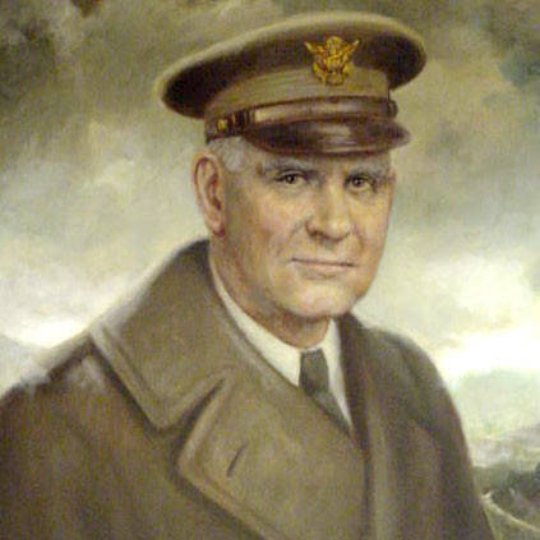
Col. William Couper, VMI Class of 1904, by Joseph Wallace King (1911-1996), Oil on Canvas
Oil portrait of Col. William Couper, graduate and longtime VMI faculty member/administrator (VMI Business Executive, 1925-1954; VMI Historiographer, 1934-1954). The first attempt to review and consolidate VMI's archival holdings was made by COL William Couper, a graduate of the Class of 1904 who spent much of his career as a senior administrator at VMI. He pursued a life-long passion for documenting Institute history and was one of the first to recognize the richness of VMI's historical records and related manuscripts and photographs. By the 1940's he had accumulated some of the most significant material and housed them in an area of the library that was then known as "Couper's Coop." Among his many published works are Col. Claudius Crozet Soldier-Scholar-Educator-Engineer (1789-1864), One Hundred Years at V.M.I. (in 4 volumes), and The V.M.I. New Market Cadets.

General Smith Announces His Plans of the Restoration of the Institute After it's Destruction to Members of the Board of Visitors and to the Academic Board 1865, Photograph of the original sketch by Willam D. Washington (1833-1870)Black and white, framed photo of W. D. Washington's sketch showing Gen. F. H. Smith speaking to 14 members of the VMI Board of Visitors and Academic Board. The mat is mounted onto the surface of the photo. When W. D. Washington died prior to completing the intended mural, B. W. Clinedinst took over the color study but also died prior to completing.
Other Areas

Bust of P. Wesley Foster, VMI Class of 1956, Bronze, by Betty Foster - Stairwell between 4th and 5th floor
Born in Forest Park, Georgia, P. Wesley Foster, a member of the class of 1956, served as both a member of the Honor Court and the Football Team while at VMI. Following his cadetship, he would work for a year and then serve two years in the 8th infantry Division of the U.S. Army West Germany until 1959. In 1968, with associate Henry Long, foster co-founded Long and Foster Real Estate, the largest private real-estate firms in the United States. in 1979, Foster became full owner of the firm after buying out Long. As an alumnus, Foster served terms on both the Board of Governors and the VMI Foundation board of Trustees. In 2006, after large donations to improve the Football stadium from Foster and his wife, Betty, VMI re-named the Stadium after them. Gift of Betty Foster.
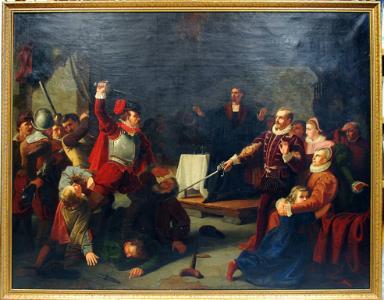
Attack on the Huguenots, Oil on Canvas, by William D. Washington
Attack of the Huguenots was painted in 1855 while Washington was studying in Dusseldorf, Germany. It depicts the 1562 massacre by Duke Francis de Guise of about 100 Huguenots attending a worship service in a barn located in Wassy, France. Washington served on the faculty at VMI until his death in 1870.

“Behold”, by Patrick Morelli (1945-), Bronze - Stairwell between 5th and 6th floors
Bronze statuette, one of eight miniatures, entitled, Behold by artist, Patrick Morelli. This portrays the baptism of infant, Kizzy, by her father, Kunte Kinte in author Alex Haley's Pulitzer prize-winning book, Roots. There is a bronze plaque on the front of the wooden base with the following engraved: "Behold / The Only Thing Greater / Than yourself, Kunte Kinte" / by Patrick Morelli / Gift of George Preston Frazer, VMI '29 This was presented to VMI Superintendent, GEN Sam S. Walker, VMI 1945, on September 25, 1985. The full-sized Behold sculpture (1980) was presented in 1990 at the Martin Luther King Jr. National Historic site in Atlanta, Georgia and dedicated to the memory of Martin Luther King, Jr.
Preston Library 5th (Main) Floor
Turman Room

Francis H. Smith, by William James Hubard, (1807-1862), Oil on Canvas
Oil portrait of Francis H. Smith who served as VMI's first superintendent from 1839 through 1889. An 1833 graduate of West Point, he had previously served briefly in the U. S. Army and was a Professor of Mathematics at Hampden-Sydney College (VA) when he accepted the position as head of the newly established Virginia Military Institute. He served for fifty years, from the Institute's infancy, through the Civil War, and through the difficult post-war period.
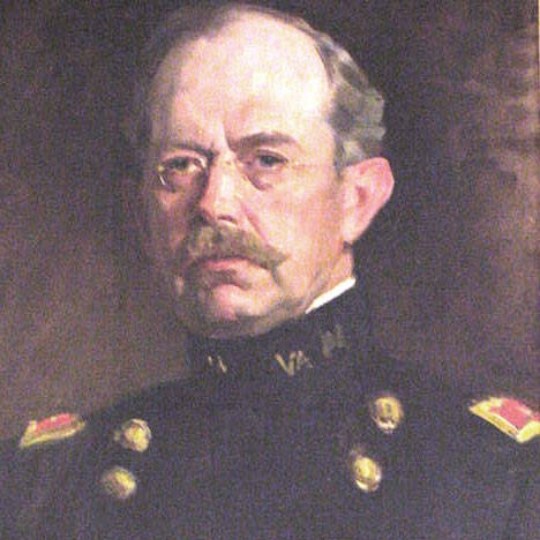
Gen. Edward West Nichols, VMI Class of 1878, by Benjamin West Clinedinst (1858-1931), Oil on Canvas
Oil portrait of VMI's third superintendent (1907-1924) Edward West Nichols. Nichols was a professor of mathematics at the Institute and served as Acting Superintendent from July 1, 1907, to June 30, 1908. On July 1, 1908, he was named VMI's third Superintendent, holding that position until September 30, 1924. Following his retirement as superintendent he continued to lecture in pure and applied mathematics. He died on July 1, 1927, because of a blasting accident on the VMI post.
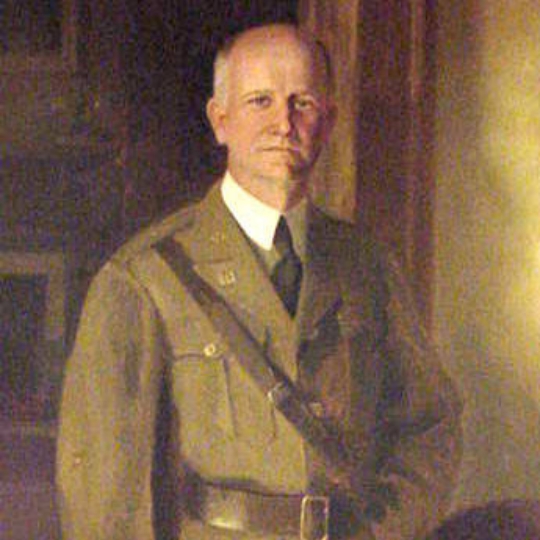
Gen. William Horner Cocke, VMI Class of 1894, Pierre Troubetzkoy, (1864-1936), Oil on Canvas
Oil portrait of William Horner Cocke, named VMI's fourth Superintendent Oct.1, 1924. He served until ill health forced his retirement June 30, 1929. The construction of VMI's gymnasium, Cocke Hall, was made possible by Gen. Cocke's significant donation towards the cost of construction.
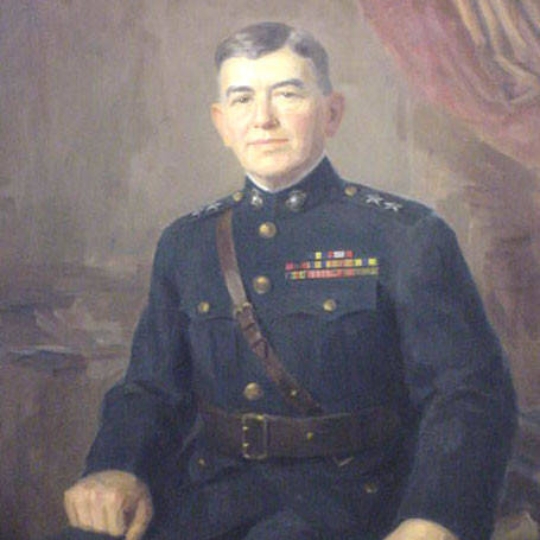
Lt. Gen. John A. Lejeune, by Davis Silvette (1909-1992), Oil on Canvas
Oil portrait of Lt. Gen. John Archer Lejeune, United States Marine Corps. Lejeune was promoted to Brigadier General in 1916 and to Major General in 1918 and served as Commandant of the U. S. Marine Corps from 1920-1929. He served as VMI's fifth Superintendent from July 1, 1929, to September 30, 1937. He was promoted to Lt. General effective Feb. 1942.

Maj. Gen. Charles Evans Kilbourne, VMI Class of 1894, by Fernando Amorsolo (1892-1972), Oil on Canvas
Oil portrait of U.S. Army Maj. Gen. Charles Evans Kilbourne, VMI's sixth superintendent. He was the first person in American history to hold simultaneously the nation's three highest military awards: The Medal of Honor, the Distinguished Service Cross, and the Distinguished Service Medal. Kilbourne became Superintendent of VMI on October 1, 1937. Kilbourne Hall, named after the major general, houses VMI's ROTC offices and classrooms.
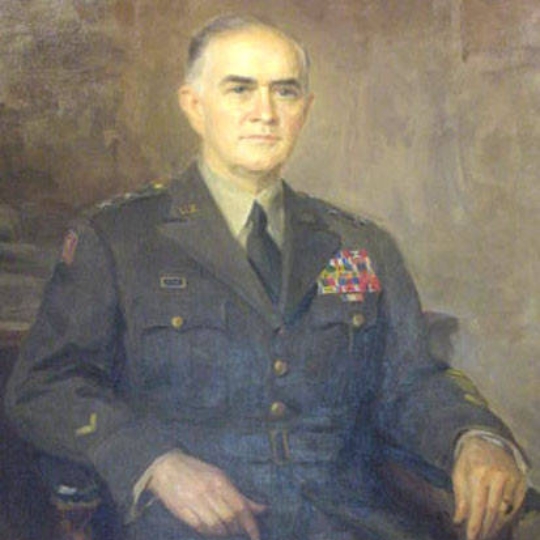
Lt. Gen. Richard Jaquelin Marshall, VMI Class of 1915, by David Silvette (1909-1992), Oil on Canvas
Oil portrait of U.S. Army Lt. Gen. Richard Jaquelin Marshall. Marshall served as Deputy Chief of Staff to General Douglas MacArthur during World War II and became his Chief of Staff in December 1945. He served as VMI's seventh superintendent from June 11, 1946, until June 30, 1952.

Lt. Gen. William H. Milton, VMI 1920, by Winslow Williams, Oil on Canvas
Prior to being named VMI’s 8th Superintendent on August 1, 1952, Milton had a 32-year career with the General Electric Company. From 1942-46 he was administrator of GE’s Hanford plutonium plant in Richland, Washington, and from 1947-50 as commercial vice president and he was assigned to customer relations in Washington, D.C. He resigned in 1950 and was named general manager of GE’s Knolls Atomic Power Laboratory in Schenectady, New York. In 1951 he was named manager of that facility’s operating department. He was the first superintendent to come to VMI with a non-military background. He remained in office until June 30, 1960.
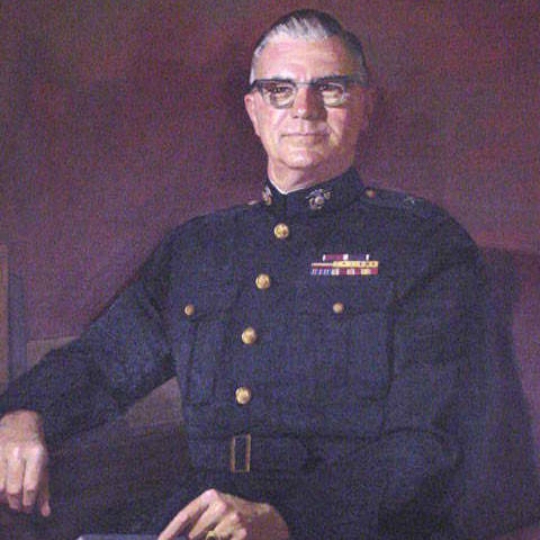
Lt. Gen. George Richard Edwin Shell, VMI Class of 1901, by Irene M. Higgins, Oil on Canvas
Oil portrait of Lt. Gen. Shell, United State Marine Corps. During World War II Shell commanded an artillery battalion in the Pacific Theater and was awarded the Purple Heart and Legion of Merit with combat "V." He subsequently served in many capacities throughout his 29 years of active duty-- on the staff of the Joint Chiefs of Staff; at the Pentagon; SHAPE; NATO; and as commanding General, Marine Recruit Depot, Parris Island. He became VMI's ninth Superintendent on July 1, 1960, serving until June 30, 1971.
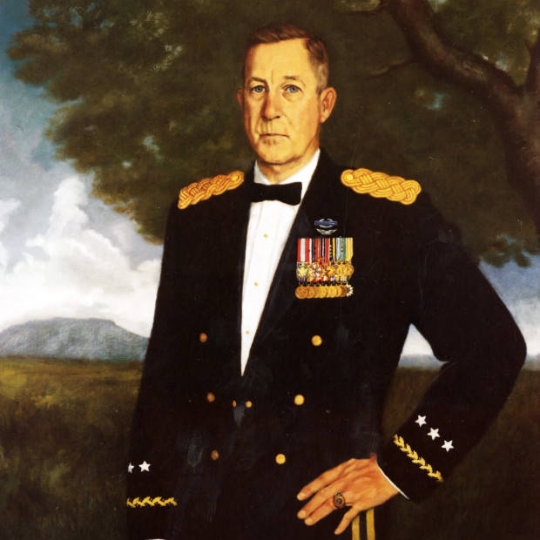
Lt. Gen. Richard Logan Irby, VMI Class of 1939, John E. C. Higgs, Oil on Canvas
Oil portrait of U.S. Army Lt. Gen. Richard Logan Irby. His military career encompassed more than 30 years of active duty and three wars, including service in China and Burma during World War II; Battalion Commander with the 1st Cavalry Division during the Korean War; and Assistant Division Commander and Division Commander with the 1st Cavalry Division (Airmobile) during the Vietnam War. In 1969 he became Commander of the U. S. Army Training Center, Infantry, at Fort Polk, LA and in 1970 he was named Commanding General at Fort Knox, Kentucky. Irby became VMI's tenth superintendent on July 1, 1971, and retired on June 30, 1981.
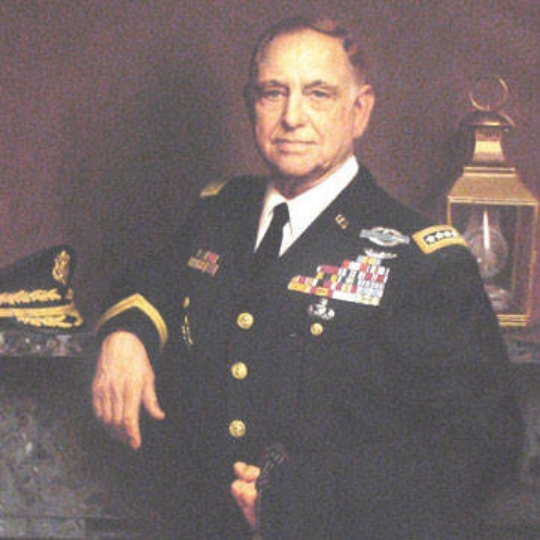
Gen. Sam S. Walker, VMI Class of 1945, by Herbert E. Abrams (1921-2003), Oil on Canvas
Oil portrait of U.S. Army Gen. Sam Sims Walker. Walker served in the U. S. Army from 1946 until his retirement as a four-star general in 1978. Among the many assignments during his distinguished military career were Commanding General, 3rd Infantry Division, USA in Europe; U. S. Commander, Berlin; Deputy Commanding General, U. S. Army Forces Command; and Commander, Allied Land Forces Southeastern Europe. He became VMI's eleventh Superintendent on July 1, 1981, and retired on December 31, 1988.
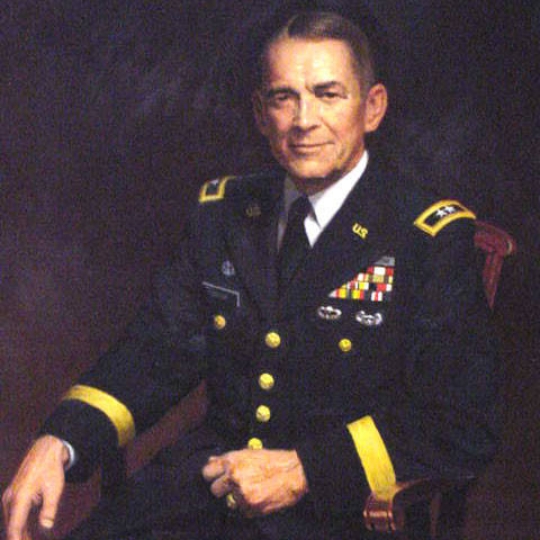
Gen. John W. Knapp, VMI Class of 1954, by Herbert E. Abrams (1921-2003), Oil on Canvas
Oil portrait of Gen. John W. Knapp, U.S. Army Reserve (retired) was named VMI's twelfth superintendent on June 15, 1989, and served until July 31, 1995. He was the first superintendent to be chosen from the Institute's faculty since 1907. At VMI, he rose through the faculty ranks to become head of the civil engineering department and in 1984 was named dean of the faculty. Now Superintendent Emeritus, he lives in Lexington, Virginia.
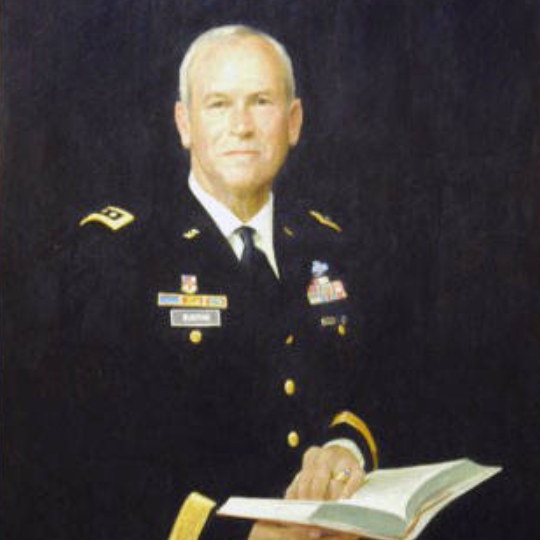
Lt. Gen. Josiah Bunting III, VMI Class of 1963, by Thomas Buechler, (1926-2010), Oil on Canvas
Oil portrait of Lt. Gen. Josiah Bunting III, who became VMI's thirteenth superintendent on August 1, 1995. He was First Captain and Regimental Commander of the Corps of Cadets, and a Rhodes Scholar. He served on active duty in the U. S. Army from 1966-1973, including a tour of duty in Vietnam. He subsequently served as President of Briarcliff College, Hampden-Sydney College, and as Headmaster at the Lawrenceville School. Bunting is also critically acclaimed author. He retired as Superintendent at the end of 2002.

General J.H. Binford Peay III, by Kyle Keith, Oil on Canvas
General J.H. Binford Peay III, graduated from the Virginia Military Institute in 1962 with a degree in civil engineering and a commission as a second lieutenant. As a cadet, he was a football quarterback, Honor Court member, and battalion commander. He later earned a master's from George Washington University and completed advanced military education. Over a distinguished career, Peay served in Vietnam, Germany, Hawaii, and numerous U.S. posts, holding key leadership positions including command of the 101st Airborne Division during Desert Shield and Desert Storm. Promoted to general in 1993, he became the 24th vice chief of staff of the U.S. Army and later led U.S. Central Command, overseeing operations across 20 countries. Following retirement, he served as CEO of the Allied Defense Group before returning to VMI. His many decorations include the Defense Distinguished Service Medal, Silver Star, and Purple Heart, along with numerous U.S. and foreign honors recognizing his exemplary military service. Peay was VMI’s fourteenth superintendent and served until his resignation on October 26, 2020.
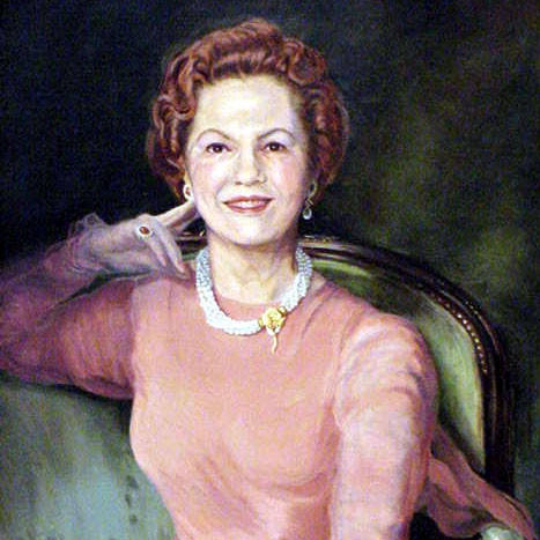
Dolly Hardee Turman, by Susie Vaughan Neikirk, (1917-2009), Oil on Canvas
Dolly Hardee Turman was a prominent New Orleans philanthropist and cultural leader, and was married to Solon B. Turman, VMI Class of 1920. Dolly provided Virginia Military Institute the largest single contribution ever of $2 million, which grew to $3.25 million in cash and securities by the time VMI received it.
Class of 1969 Memorial Room (Periodicals Room)
Four members of the VMI Class of 1969, who were killed in the Vietnam War, are honored with portraits based on photographs from their cadetships.

From left to right:
Thomas G. Blair, Jr. (1947-1971) Following his cadetship at VMI, Thomas served as an infantry officer in the Army. His graduate uniform showcases this career path with the crossed rifles on his collar. In May of 1971, Thomas was killed in ground combat in the Thua Thien province of Viet Nam. Captain Blair demonstrated valor and bravery in the face of death and was awarded the silver star.
Arthur L. Galloway, Jr. (1947-71) or "Lee" as he was known by his classmates, was a graduate of VMI's class of 1969. He was an athlete and graduated with a degree in modern languages. Following his time as a cadet, Arthur entered service as an officer in the Army. He was an infantry commander. In March of 1971 1st Lieutenant Galloway was killed in the Quang Nam province of Viet Nam through small arms fire.
John W. Kennedy (1947-71) was a distinguished athlete, friend, and member of the Institute's class of 1969. John was known for his sincere personality, was a member of the honor court, and co-captained two athletic teams. After graduating with a degree in civil engineering, John joined the Airforce to be a pilot. He served with the 20th Tactical Air Support Squadron. In August of 1971, while flying a reconnaissance of the Quang Tin province of South Viet Nam, radio communication was lost with John's aircraft. Captain Kennedy was declared MIA, and his remains were recovered two decades later.
Franklin W. Webb (1946-68) was a brother rat of the Institute's class of 1969. Frank's cadetship at VMI was cut short due to the war. He gave up the opportunity of graduating with his friends to go and fight for his country. He served as an infantry officer in the Army. In May of 1968, Frank was killed in action in the Binh Dinh province of South Vietnam. For his acts of valor, 1st Lieutenant Webb was awarded the silver star, the third highest decoration for valor.

Three Soldiers, by Frederick Hart (1943-1999), Bronze
In 1982 the Vietnam Veterans War Memorial Fund commissioned Frederick Hart to create a representational sculpture. The full size "Three Soldiers" statue graces the Vietnam Veteran's Memorial in Washington, D. C. The original sculpture is angled so that it faces the Vietnam Memorial Wall. A gift of James Moore and Family, and the VMI Class of 1958.

The Minute Man, by Hans Schuler after Daniel Chester French
The statue portrays a minuteman pausing from his work at the plow to take up arms in defense of liberty at the Battle of Concord. Draped with an overcoat and holding a long gun, the figure evokes a powerful sense of civilian resolve. While 19th-century scholars believed the pose closely mirrored that of the Apollo Belvedere, more recent insights from sculptor Daniel Chester French’s own journals reveal that The Minute Man was inspired by multiple classical references, with the Apollo serving as just one among several artistic influences.
Other Areas
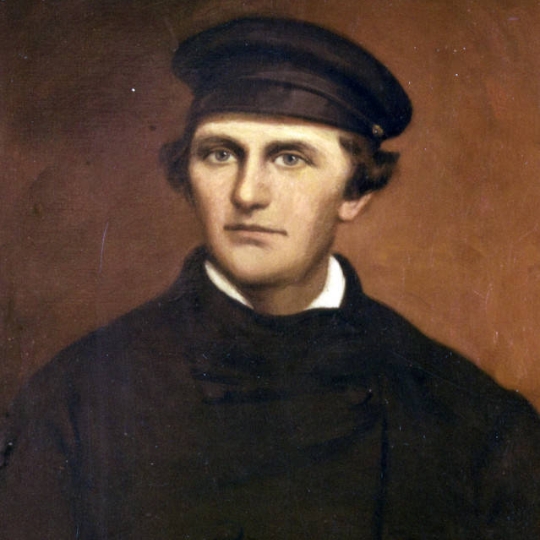
John T. L. Preston, c. 1840, copy of original oil portrait by Adele Williams, Photographic Print on Canvas - Main Entrance
John T. L. Preston was one of the founders of VMI and served on the faculty from 1839-1875. Preston Library is named for him. The oil portrait was painted in 1907 by Adele Williams.
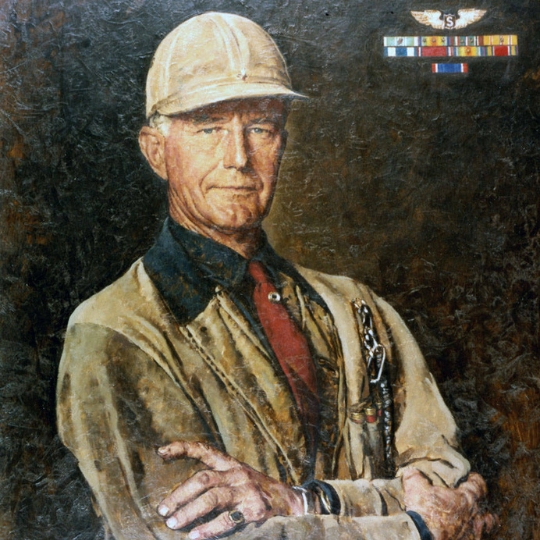
VMI Alumnus Henry Fairfax Ayres, VMI Class of 1906, by Norman Rockwell (1894-1978), Oil on Canvas
COL Fairfax Ayres, painted by the prominent American artist and Vermont neighbor Norman Rockwell. Born in Loudon County, VA, 1886, Ayres matriculated with the class of 1906, but transferred to the United States Military Academy, in 1908. He served in both World Wars, earning a citation for gallantry during the Meuse-Argonne offensive in World War I and a bronze star with the Army Air Corps in World War II. He also showed his skill in the private sector, proving himself to be a capable businessmen and inventor, developing a milk sterilizer and a steel railroad brace. He fostered a close relationship with VMI, giving many generous gifts and donations throughout his life. He died in Vermont in 1979.
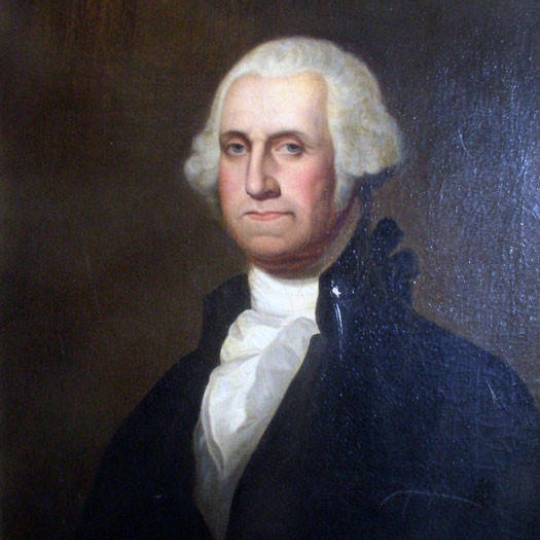
George Washington, by Gilbert Stuart (attributed) (1755-1828), Oil on Canvas
George Washington (1732-1799) was commander of the continental army during the American revolution and the first president of the United States. One of Americas Founding Fathers, George Washington helped to build America's government from the ground up and is considered America’s first citizen-soldier. This painting was presented to VMI by Mrs. H. T. Morrison in memory of her husband, Brigadier General Henry Terry, a graduate and member of the VMI class of 1920. This work was painted by either Gilbert Stuart or one of his students in 1790, a renowned artist from the late 18th century. The patriotic motif frame was made in 1820.

Gen. William H. Richardson, by William James Hubard (1807-1862), Oil on Canvas
Gen. William H. Richardson of Richmond, VA was a member of the VMI Board of Visitors 1841-1876; Adjutant General of VA 1841-1876 (except 1865-1870); Capt., War of 1812; first State Librarian; and Secretary of the Commonwealth. This portrait is by the artist William Hubard.
6th Floor
Gallery
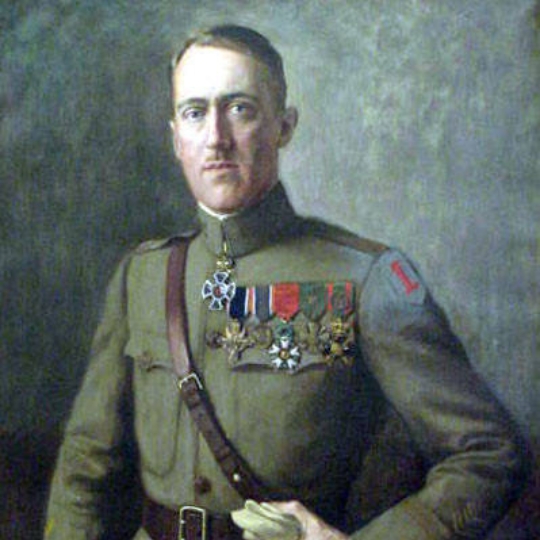
Col. John Downer, U. S. Army, VMI Class of 1902, by Asen, Oil on Canvas
From 1901 to 1943, Downer served in the United States Army and was with the American Expeditionary Force, commanding 1st and later 2nd Battalions, 6th Field Artillery in France during World War I. In 1920, he was a member of the United States Riding Team at the Seventh Olympic Games and served as an American representative on the United States Olympic Committee.
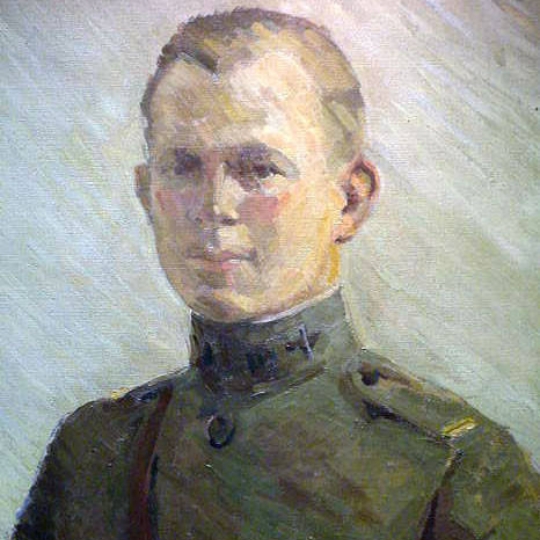
Lt. Edward T. Hathaway, VMI Class of 1915, by John Clark Tidden (b.1889)
Edward Trafton Hathaway (1892-1918) attended VMI from 1911-1913. After leaving VMI, he served in the 90th Aero Squadron during the first world war. On the 25th of June 1918, Edward was killed in battle in Lorraine, France; he was only 25 years old. The painting was created by John Clark Tidden (1889-1957) in 1917.
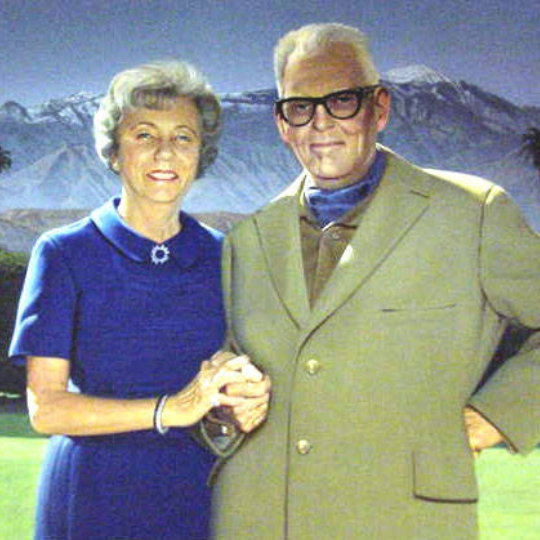
Laurence Oakes with His Wife, by Robert Rishell (1917-1976), Oil on Canvas
Portrait of Laurence Oakes, VMI Class of 1917, and his wife, set in Palm Springs, California. Captain Oakes served as an Officer in the Motor Transport Corps of the American Expeditionary Force during World War 1.

Road to Cordoba by Aldo Luongo (1941-), Oil on Canvas
A gift of Charles P. Tolley, VMI Class of 1956.

George Washington Kneeling in Prayer maquette by Donald DeLue (1897-1988), Bronze
A gift of George Preston Frazer, VMI Class of 1929, in honor of Sir Moses Ezekiel, VMI Class of 1866. The original brass statue named The Prayer at Valley Forge depicts General Washington praying in the woods during the Revolutionary war. Donald DeLue Studied at the Boston Museum of Fine Arts School. He later served as President of the National Sculpture Society.
Other Areas
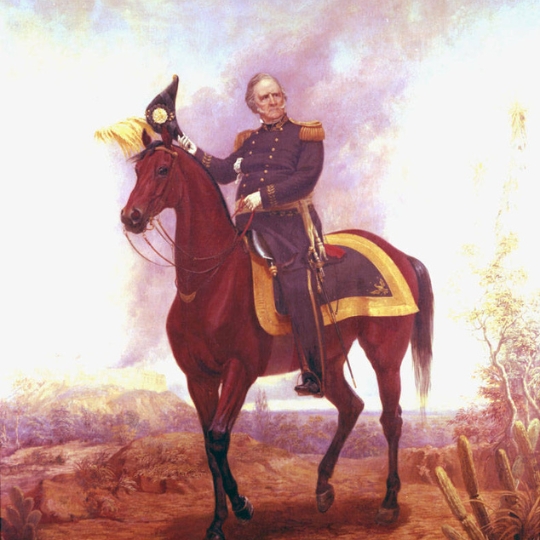
General Winfield Scott, by Edward Troye (1808-1874), Oil on Canvas - Lounge
This portrait by Edward Troye depicts Winfield Scott atop his horse in Chapultepec, Mexico, during the Mexican American War. It has been on loan from the US Capitol Collection, Washington, D.C since 1939. General Scott served as a Lieutenant General which at the time was the head of the US Army. He led men in the War of 1812, The Mexican American War, and briefly during the Civil War. The Mexican American War was specifically significant for General Scott because as General of the Army he was not needed in the country but after his appointed general proved to be the wrong fit, Scott himself led the Army to victory. Scott holds the record for the greatest length of active service as general in the U.S. Army, as well as the longest tenure as the army's chief officer.
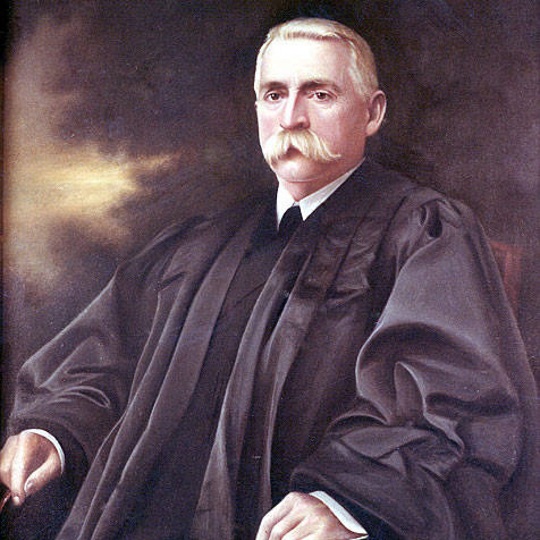
Judge Erskine Ross, VMI Class of 1865 by James P. Walker (1819-1889), Oil on Canvas - Room 608
Erskine Mayo Ross (1845-1928), class of 1865, was a graduate of VMI and successful Judge in the US circuit court of appeals. Ross attended the Virginia Military Institute for his undergraduate education and had to leave the school twice to fight in the civil war. He was a veteran of the battle of New Market. Following his time at VMI, Ross went to California to study law under his uncle Cameron E. Thom. This painting depicts Ross wearing his court gown, representing his commitment towards justice in the United States. The painting was completed in 1912 by John P. Walker, an artist known for painting state and civil war figures.
7th Floor
Classroom

John L. Dillard, VMI Class of 1896, by Joseph Wallace King (1911-1996), Oil on Canvas
John Lea Dillard (1877-1959) was a graduate and member of VMI's class of 1896. After obtaining a degree in Civil Engineering, John Dillard married tobacco heiress Mary Symington Taylor. He eventually became president of a construction firm which built the world's largest double track railroad tunnel close to Elkhorn, West Virginia. Dillard served as president of the VMI alumni association from 1938-1940, and was the uncle of Herbert Nash Dillard, Jr., VMI 1934 - a favorite VMI professor and Glee Club Director.
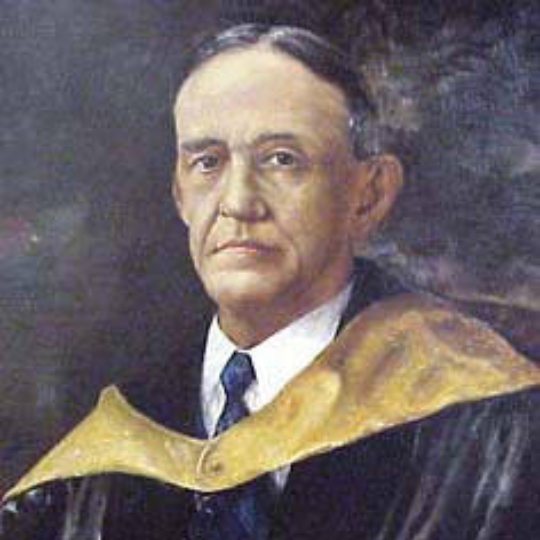
Charles M. Snelling, VMI Class of 1894, by Anna M. Sandwich, Oil on Canvas
Charles Mercer Snelling (1862-1939) was a graduate and member of VMI's class of 1884. After graduation, Charles taught mathematics at VMI and at the Georgia Military Institute. Throughout his very successful academic career Charles held many high-ranking positions such as Chancellor of the University of Georgia from 1926-1932 and the first Chancellor of the Georgia Board of Regents of the University System of Georgia from 1932-1933. This painting depicts Charles while serving as chancellor of the University of Georgia. This painting was gifted to VMI by Elizabeth Snelling Rucker and W. Vance Rucker.
.svg)
.png)

